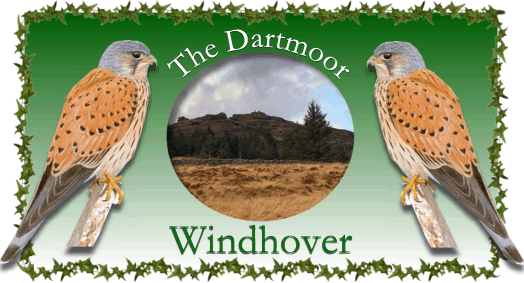
On Dartmoor the kestrel is affectionately known as either the ‘Windhover’ or the ‘Wind-Fanner’ which compared with its Latin name of Falco tinnunculus is a great improvement. These days any sightings of the bird will be confined mainly to the moorland edges or near woodlands and plantations. Sadly, the plight of this small falcon is not one of Dartmoor’s success stories as the population has been in decline. In 1834 Eliza Bray made this curious comment on the Windhover:
” I have dissected many, and have never found anything in the stomach but a small green lizard, which I have not been able to find alive.”
This in itself suggests that during this time the birds were often caught or killed. However the early twentieth century saw a nationwide increase in the kestrel population due to decreased persecution. The war years meant that many gamekeepers and the like were serving in the forces which meant the hunting estates were not as well ‘keepered’ as before. By the early 1960’s this upturn was seen on Dartmoor with the Postbridge population increasing from one to two breeding pairs with two more pairs recorded in the West Webburn valley. The windhover numbers then fluctuated from between one and five breeding pairs each year. By 1985 there was a notable decline across the whole of Devon and by which time there was a marked increase in the numbers of buzzards and sparrowhawks. This decline continued into the 1990’s where in 1990 the windhover was described as being’ “amazingly scarce,” in the Postbridge area. By 1991, despite there being two or three single birds none of these were noted forming a breeding pair. Numbers increased slightly the following year with about six birds of which two formed a breeding pair. The Dartmoor National Park Authority commissioned a survey in 2000 and estimated that over the entire moor there were between 10 – 38 breeding pairs.
There is some question about the accuracy of these figures because it is possible that the windhovers migrate down to the lowlands in extreme winters. Studies have suggested that during the months of January and February the Postbridge area displays a consistent decrease in windhover numbers. During the late summer and autumn it is possible to see family groups hunting over the open moor. There have been occasions when between 5 and 6 birds have been sighted with what are assumed to be mixed family groups of up to ten birds.
The kestrel’s main prey are small mammals, especially voles and birds such as larks and pipits, but obviously now and again as Mrs Bray noted they will take small reptiles. On average a windhover needs to eat around about a fifth of its weight in food each day which roughly equates to 2 voles.
There seems to be two ways in which the bird hunts, firstly, it will hover facing the wind at a height of about 20 -30ft where with wings quivering and tail spread wide it searches for its prey. If no meal is found it will move on and repeat the process. The windhover is the only falcon that has this ability to stationary hover in the air – hence its name – windhover/fanner. On spotting their victim they will go into a headlong dive, then the windhover seems to temporarily screech to a halt close to the ground before making the final plunge with its feet splayed forwards. The second method is where the bird sits on a high vantage point and watches for its prey. Once a meal has been located the bird goes into a steep but short dive and pounces on the hapless victim. The windhover have a natural ability to see into the ultra-violet spectrum which means they can detect the ultra-violet light reflected in the vole’s urine which is left as it marks its trail.
Apart from its name there is amazingly enough very little folklore attached to the windhover, in fact there is none that I have been able to find. Whether or not this is connected to its scarcity on Dartmoor I don’t know. The bird does not even show up in any place-name evidence despite the tempting name of ‘Kestor’.
 Legendary Dartmoor The many aspects past and present of Dartmoor
Legendary Dartmoor The many aspects past and present of Dartmoor
